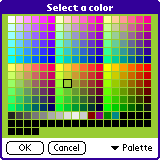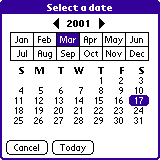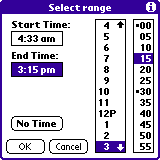| title | a string being displayed as the dialog title |
| col | color number, an integer in the range 0-255 |
 pick-color displays the system dialog to let the user
select a color. The initial color selected is col.
The index of the selected color is returned, or
#f if the user canceled the dialog. On systems running
older OS versions than 3.5, 0 is returned immediately without
displaying a dialog.
pick-color displays the system dialog to let the user
select a color. The initial color selected is col.
The index of the selected color is returned, or
#f if the user canceled the dialog. On systems running
older OS versions than 3.5, 0 is returned immediately without
displaying a dialog.
| (pick-color "Select a color" 123) | => | 123 depending what the user selected. |
 pick-date displays the system dialog to let the user
select a date. The initial date selected is date.
The new date selected is returned as a date
or #f if the user
canceled the dialog.
pick-date displays the system dialog to let the user
select a date. The initial date selected is date.
The new date selected is returned as a date
or #f if the user
canceled the dialog. pick-time displays the system dialog to let the user
select a time. The initial time selected is time.
The new time selected is returned as a time value
or #f if the user canceled the dialog.
pick-time displays the system dialog to let the user
select a time. The initial time selected is time.
The new time selected is returned as a time value
or #f if the user canceled the dialog. pick-time-range displays the system dialog to let the user
select a time range. The initial start time selected is
time1, the initial end time is
time2 if specified, or the start time
otherwise.
The new time range selected is returned as a list of two time values
or #f if the user canceled the dialog.
pick-time-range displays the system dialog to let the user
select a time range. The initial start time selected is
time1, the initial end time is
time2 if specified, or the start time
otherwise.
The new time range selected is returned as a list of two time values
or #f if the user canceled the dialog.